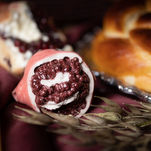About my process

I make molds of real life objects, usually food, and I love the detailed textures and little realistic quirks to each item. I like to take a mold of several examples of the item - 5 different jalapenos to exemplify their character.
The molds are made in at least two pieces, so that they can open up and release the cast. I make one half of the mold by building up clay to a midpoint line on the object, then boxing in the submerged shape with wood cottles, and pouring liquid plaster on top. After the plaster has set, I flip the whole mass over, remove the clay, and pour another batch of liquid plaster on the exposed object.
The number of mold pieces and the shape of each is dictated by how intricate the objects are.
mold making
slipcasting

Once I have molds made, I use liquid clay (called slip) to cast porcelain copies of the real object.
I make my own recipe of slip, in 30 gallon batches, from 50lb bags of powdered minerals and clays. It is stored in a big tub with a pump and wooden slats above, so that I can easily fill and drain several molds at the same time, balanced on top.
The plaster that the molds are made from is extremely absorbent, so when liquid clay is poured in, the plaster sucks the water out of the slip, turning into solid clay where it is touching plaster (the shell), leaving the inside liquid like a gusher candy. Once the walls build up to a desired thickness, I flip the molds upside down to drain back into the tub.
I take apart the molds, carefully remove the casts and store them in plastic bins, to later alter into finished pieces.
glazing & finishing

Every object that I make has to be fired at least two times: once to permanently harden and dry out the clay (about 1800°), and again to turn the porcelain into hard china, and melt the glaze into colors (about 2200°).
Glazing can be one of the most frustrating parts of ceramics! I've had a lot of fails in this process, but repetition has done wonders. I buy my glazes in dry form from Laguna Clay, and I mix them to my own specifications, sometimes mixing them, to make a big library of glaze colors to choose from.
An optional last step of my process is to add an overglaze of real 22k gold. This is a noxious oily liquid with real gold dissolved in it, so it costs $130 for a very small bottle! I paint it on carefully, after the glaze firing, and then stick it back in the kiln for a much lower firing (about 1200°).

























































